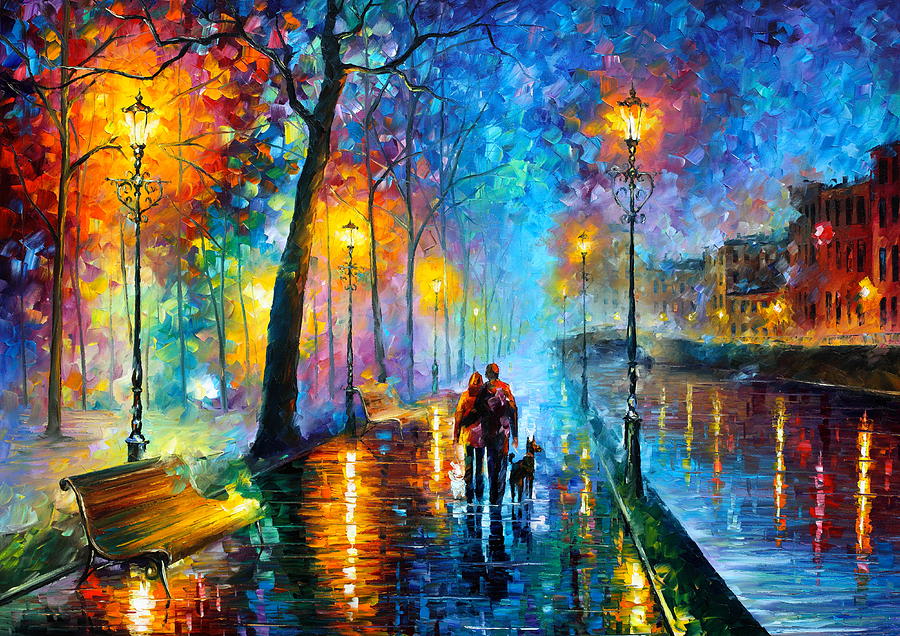Wednesday, April 29, 2015
Sunday, April 19, 2015
HarmonIntroImpressionismPostImpressionism
April 19, 2015
HUA101
Online
Assignment #4
Impressionism
is a style of painting that originated in France about 1870. Paintings of
casual contemporary subjects were executed outdoors using divided brush- strokes
to capture the light and mood of a particular moment and the transitory effects
of natural light and color. Impressionism art focused more on what the eyes see
rather than what the mind knows, according to the lecture Harmon Intro Impressionism
Post Impressionism. Certain impressionism art had something called open form or
“cropping the image” which is a form whose exterior is irregular or broken,
having a sense of growth, change or unresolved tension; from in a state of
becoming or reaching out.
 This piece of impressionism artwork is
called Melody of the Night by Leonid Afremov.
This piece of impressionism artwork is
called Melody of the Night by Leonid Afremov.
Post-Impressionist believe in a free
interpretation of nature, not to see things but to see through them to a
significance in reality deeper than what superficial appearance gave according to
the lecture. This period developed from about 1885 to 1900 in reaction to what
these artists saw as the somewhat formless and aloof quality of Impressionist
painting. This is also art created by French artists. These artists were
considered “Beings of extraordinary insight, mysterious, visionary and fantastic.
Post-impressionist used paint while other artist were using pencil, sketch,
painting quickly and with a lot of rhythm.
 This piece of Post-Impressionism art is
called Starry Fright by Vincent Van Gogh.
This piece of Post-Impressionism art is
called Starry Fright by Vincent Van Gogh.Monday, April 6, 2015
HarmonIntroRenaissanceBaroque; Museum visit
April 6th, 2015
HUA101
Online Assignment #3
The Renaissance, or Rebirth, is
a period in Europe from the late fourteenth through the sixteenth centuries,
which was characterized by a renewed interest in human centered classical art,
literature, and learning. This was connected with humanism. Humanism was a
cultural and intellectual movement during the renaissance, following the
rediscovery of the art and literature of ancient Greece and Rome etc. The
philosophy of humanism, presented in the lecture while talking about the art
Masaccio, was a legacy of the Greeks and Romans. It was a code of civil conduct
and a theory of education. Renaissance art consisted of styles such as frontal
poses with prominence, halos and uses of gold leaf which emphasizes flatness.
It also highlights the prominent role of religious orders.
.jpg)
 This portrait is The Holy Family with the Infant Saint John
the Baptist by Perino del Vaga. He was an Italian painter of the late
renaissance. Vaga was born in Florence, Italy in 1501 and died in Rome, Italy
in 1547. This rare work dates from the mid- 1520’s. Young Christ holds
traditional symbols of a goldfinch which is symbolic of the resurrection and a
cherry, signifying the “delights of the bless”. Young Saint John the Baptist
who is the cousin of Christ, wore leopard skin was usually associated with the
ancient god Bacchus. The pagan and Christian mirrors ideas prevalent
This portrait is The Holy Family with the Infant Saint John
the Baptist by Perino del Vaga. He was an Italian painter of the late
renaissance. Vaga was born in Florence, Italy in 1501 and died in Rome, Italy
in 1547. This rare work dates from the mid- 1520’s. Young Christ holds
traditional symbols of a goldfinch which is symbolic of the resurrection and a
cherry, signifying the “delights of the bless”. Young Saint John the Baptist
who is the cousin of Christ, wore leopard skin was usually associated with the
ancient god Bacchus. The pagan and Christian mirrors ideas prevalent
The Baroque period was the
seventeenth-century period in Europe characterized in the visual arts by
dramatic light and shade, turbulent composition, and pronounced emotional
expression. Some of the arts were of religious experience. The Greek mythology
was that being nude was the highest form of beauty. The dramatic shade created
an illusion of volume.
.jpg)
 This is Venus and Adonis by Peter Paul Rubens. Rubens was a Flemish Baroque
painter who was born in Siegen Germany in 1577 and died in Antwerp, Belgium in
1640. This painting was dated back to about the mid 1630’s. Mistakenly hit by
one of cupid’s arrows, Venus, the Goddess of love, fell in love with the
handsome and strong hunter Adonis. With manly indifference to the goddesses’
charm and her warning of danger, Adonis hunted a wild bear and was gored to
death. The story was well suited to decorate grand country houses, where the
chase occupied noblemen indoors and out.
This is Venus and Adonis by Peter Paul Rubens. Rubens was a Flemish Baroque
painter who was born in Siegen Germany in 1577 and died in Antwerp, Belgium in
1640. This painting was dated back to about the mid 1630’s. Mistakenly hit by
one of cupid’s arrows, Venus, the Goddess of love, fell in love with the
handsome and strong hunter Adonis. With manly indifference to the goddesses’
charm and her warning of danger, Adonis hunted a wild bear and was gored to
death. The story was well suited to decorate grand country houses, where the
chase occupied noblemen indoors and out.
Subscribe to:
Comments (Atom)
